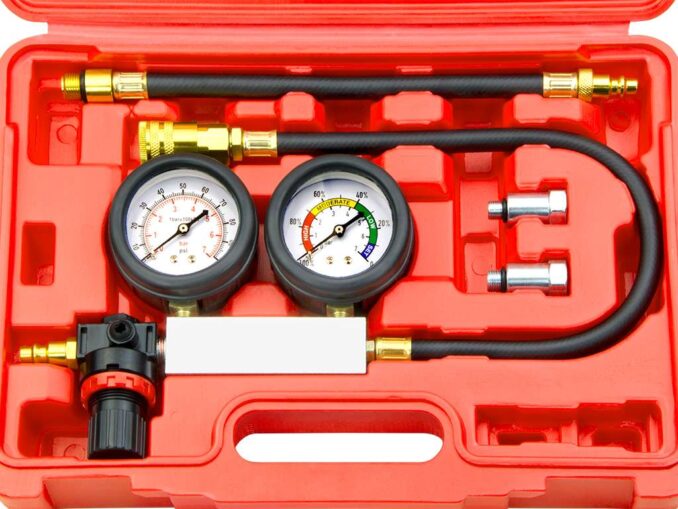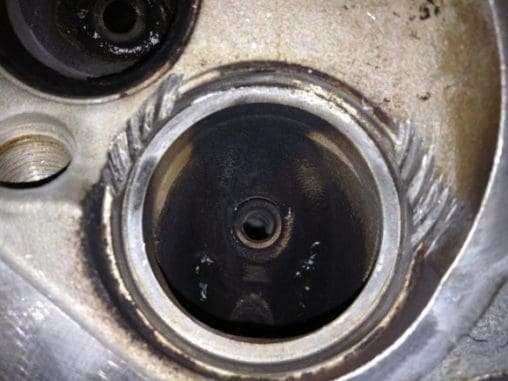
Doing a cylinder leak down test, especially in conjunction with a compression test. Should allow you to quickly determine, the basic condition of any engine.
So, a compression test is a “dynamic test” (engine moving). On the other hand, a cylinder leak down test is a “static test” (engine at rest).
So, the compression test measures how much pressure, the engine can produce while cranking. In contrast, to the cylinder leak down test, which measures how much pressure, is lost in the engine.

In a cylinder leak down test the engine is placed on top dead centre (TDC), of the cylinder in question. Then, using a similar type of connector as the compression test, we fill the cylinder with pressure. The tester then measures the volume of air needed to maintain, a predetermined pressure in the cylinder.
Firstly, the cylinder leak down test reading is shown in a percentage. Consequently, good cylinder leak down readings should be below 5-8%.
So, the great thing about the cylinder leak down test. It that it deals with how well the cylinder is sealing, and nothing else. Furthermore, the readings are not affected by, cam timing, or even engine cranking speed.
Another great feature of the cylinder leak down test. The fact that you can hear, where the air is leaking out of the cylinder. When a cylinder has high percentage of leakage, first check the oil filler cap. Do you hear a hissing sound? If so, you may have pressure leaking by the piston rings.

Is there air leaking out the exhaust? Is it leaking out the intake system? Then a burned valve may be the problem. If two adjoining cylinders have similar low readings, and you hear leakage out the other cylinder. Then, a blown head gasket may be the problem.
So, being able to find the exact source of the compression loss. Will tell you where the problem is, and not just that you have one. Finally, this knowledge will greatly assist you in the next step… the repair.
This is my favorite engine test to do, because it can quickly point you in the right direction.
Cylinder Leak Down Test Findings – What Are The Results Telling You:
INTAKE VALVE OR INTAKE VALVE SEAT
Air will escape past the valve, and into the intake manifold.

Sound should be audible in the throttle plate, or air cleaner assembly. Be sure to have the (PCV) valve disconnected, so you don’t have a false positive.
EXHAUST VALVE OR EXHAUST VALVE SEAT
Pressure will leak into the exhaust manifold, and ultimately out the exhaust. Will probably be more audible, than felt at the exhaust pipe.
PISTON RINGS
Crankcase is pressurized, leading to air leaking through the (PCV) valve or breather. Possibly any other passage to the outside, like the dipstick tube. If the (PCV) valve is left hooked up to the intake, it could cause a false positive.
CYLINDER HEAD
A cracked head might fail a cylinder leak down test, if it’s really, really badly damaged.

Depending on the head design, it could leak into the water passage, leading to bubbling, audible in the radiator. Into the oil passage leading to noise at the (PCV), or another crankcase opening. To an intake or exhaust port leading to a sound, similar to a failed valve or seat. However, this is a less likely failure.
CYLINDER HEAD GASKET
Typically a badly failed cylinder head gasket will be evident, when the head is removed. As a result, there will be evidence of combustion in the gasket, or on the mounting surfaces.
CYLINDER WALL
A badly scarred or gouged cylinder wall, could let pressure past the piston rings.

Should sound the same as a bad piston ring. The only way to tell would be to remove the head, and physically inspect it.
PISTON
Again, will show up the same way, as a cylinder wall or piston ring. Visual inspection would probably tell you.
SPARK PLUG
Probably difficult to tell on a cylinder leak down test, unless pressure leaks past the fitting.
FUEL INJECTOR
On DI engines. Should leak past the injector to the outside, or into the injector and into the fuel rail, theoretically.
To Look At It Another Way, In Order Of Likelihood:
- Tailpipe – exhaust valve or seat, cylinder head gasket, cylinder head.
- Throttle body, intake, or air cleaner – intake valve or seat, cylinder head gasket, cylinder head.
- Radiator – cylinder head gasket, cylinder head.
- (PCV), Breather, or other crankcase opening – piston rings, cylinder wall, piston, cylinder head gasket, cylinder head.
- Outside – spark plug, cylinder head gasket leak, cylinder head, DI fuel injector.
Conclusion
Remember, start with simple, more likely failures, before assuming something catastrophic. Consequently, gaskets, valves/seats, and rings are all good places to start, depending on the symptoms. Finally, cracked heads, cracked pistons, and bad DI fuel injectors, are all pretty small possibilities. Finally, that’s why a cylinder leak down test, is a great test.
BY DANNY BENDER




